In 2012 I was introduced to this fly by Jeremy Lucas in a training session leading up to the 2012 World Fly Fishing Championships in Slovenia.
The waters of the Korka had mayfly hatching but I was having trouble in findinga fly that didn’t spook them. Remembering that browns were behaving in a similar way in the traing session I mentioned above I swapped over to the plume and ultimately did pretty well for the session coming in 10th out of 28 competitors. This fly accounted for all of the fish I caught in that session.
This is a particularly good fly for slower moving water with mayfly feeders evident but unresponsive to more robust flies.
Jeremy’s original tie utilises heron herl for the body but I have found that impossible to get in Australia so I have substituted the herl from the feather of various duck. Using a duck herl has its advantages as I have a range of duck feathers to select from and have found that I can pretty well match the body colour to the natural mayfly that I am seeking to imitate.
Materials
| Hook |
Thread |
Body |
Wing |
Thorax |
| #12 to #16 Dry |
Uni-thread – Trico 17/0 |
Duck feather herl |
CDC feather/s |
CDC “dubbing” |
Process
| A |
- Wind on the thread in touching turns from the eye to just short of bend of the hook.
[member Link=”p=10018″ Title=”Understanding hooks”]
- Depending on the size of the fly tie in between 1 and 3 herl from a duck body feather.
|
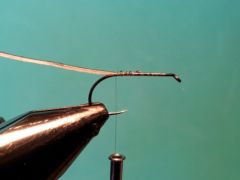 |
| B |
- Form the herl into a herl rope.
- Wind the herl rope in touching turns along the rear 3/4of the hook shank forming a thin body.
- Trim the excess herl.
[member Link=”p=700″ Title=”Roping herl”]
|
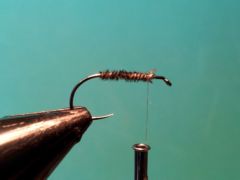 |
| C |
- Select 1 or 2 CDC feathers. For this size #12 fly I have selected 2 and have arranged them with the concave sides facing together.
- Hold them in position with enouth plume facing out the front of the fly to forman emerging wing about the length of the hook shank.
|
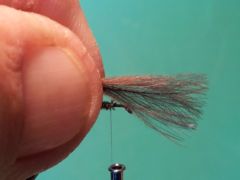 |
| D |
- Tie the wing into place witha couple of firm wraps of thread.
- At this stage check the length of the wing and if necessary you can pull the wing back a little by the but ends to shorten the wing.
|
 |
| E |
- Trim away the butt end of the plumes and take a couple of extra firm wraps of thread to ensure that the wing is locked into position.
- trim away a bit of the CDC from the discarded butt ends and dub that onto the thread.
|
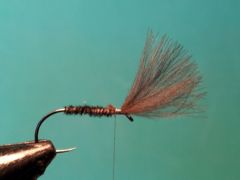 |
| F |
- Using the single strand method of dubbing dub on a CDC thorax.
- Take the dubbing rope forward in front of the wing and take just 1 or 2 wraps of the dubbing rope there to ensure that the wing stand up slightly.
- Remove the excess CDC dubbing.
|
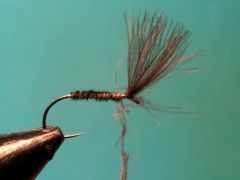 |
| G |
- Build up a neat thread head
- Whip finish and varnish the head.
|
 |








